Japan hopes to immortalize its kamikaze pilots – a squad of young men who crashed their aircraft into Allied ships in World War Two – by seeking Unesco World Heritage status for a collection of their letters. Rupert Wingfield-Hayes meets the former pilot who built the collection, in honour of his fallen comrades.
Tadamasa Itatsu is a spritely 89-year-old with twinkling eyes and a firm handshake. He cancelled his tennis game because I was coming, he tells me.
In March 1945 Itatsu-San was a 19-year-old pilot. Hundreds of American and British battleships and aircraft carriers were sailing towards Okinawa. He was asked by his commander to volunteer for one of Japan’s infamous “special attack” squadrons.
“If Okinawa was invaded, then the American planes would be able to use it as a base to attack the main islands of Japan.” He tells me: “So we young people had to prevent that.
In March 1945 it was a normal thing to be a kamikaze pilot. All of us who were asked to volunteer did so.”
Itatsu-San did not die. As he flew south towards his target, his engine failed and he was forced to ditch in the sea. He returned to his unit, but the war ended before he could try again.
I Word Understanding
Immortalize – idolization
II Have your say
1. What should the world make of the Kamikaze Letters, and should they be given World Heritage status?
2. “Kamikaze letter are treasure to be passed down to future generations”, according to Itatsu
San. Let’s take a look at one of the Kamikaze letter. What springs into your mind about the letter?
As Hayashi Ichiz? (kamikaze pilot) wrote: “There must be some peace of mind for dedicating
my life to the emperor. . . . To be honest, I cannot say that the wish to die for the emperor is
genuine, coming from my heart. However, it is decided for me that I die for the emperor.”
3. Ann Frank’s Diary is among the most enduring documents of the twentieth century. Can you
still recall the gruesome experiences of Ann Frank and her family during the Nazi occupation?



